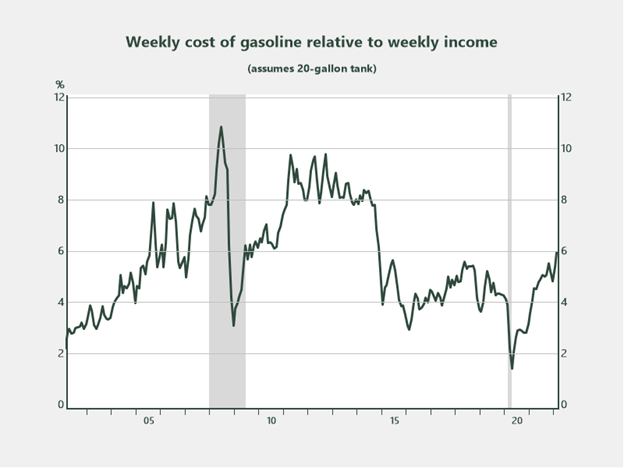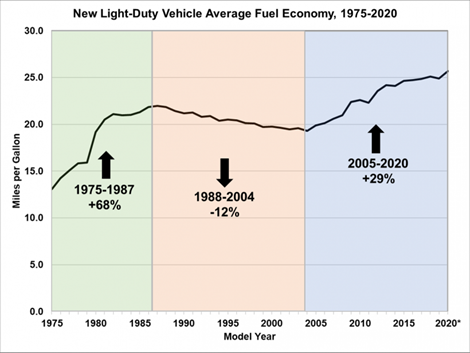Have you ever skilled sticker shock on the pump just lately? Likelihood is, you in all probability seen a value hike the final time you topped off your tank. In response to the Power Data Administration, the value of typical gasoline has risen 57 % prior to now yr, and shoppers are feeling the squeeze.
So, how unhealthy is it? The headlines are telling us that gasoline costs have by no means been larger. However is that this probably the most we’ve ever paid for gasoline on the pump? Technically, sure, however there’s extra to the story.
Nominal Vs. Actual Costs
The headlines and fears about all-time highs in gasoline costs are taking part in into an financial concept referred to as cash phantasmwhich is the tendency for shoppers to view their wealth (and costs) in nominal phrases quite than actual phrases. To assume in actual phrases, it’s necessary to grasp that the buying energy of a greenback in March 2022 shouldn’t be the identical because it was in March 1992. Costs rise over time, so the worth of a single greenback will decline over time because it buys fewer items and companies, all else equal.
Let’s stroll via an instance as an instance what I imply. Let’s say your revenue in 1992 was $10,000 per yr and the fee to purchase a used automotive was $5,000. Over the following 30 years, each your revenue and the value of vehicles enhance; in 2022, they’re $50,000 and $25,000, respectively. In relation to your revenue, the price of a automotive as we speak is identical because it was in 1992 (one-half revenue). In actual greenback phrasesthe fee to you has remained the identical over the complete interval, though the sticker value of the automotive has elevated over these 30 years. Alternatively, in case your revenue had solely elevated to $40,000, the price of the automobile would’ve elevated in actual greenback phrases as a result of it could require a bigger portion of your revenue.
Budgeting for Gasoline
Let’s apply the identical logic to the price of gasoline in as we speak’s surroundings. At present, the typical value of typical gasoline is about $3.50 per gallon. (This worth most definitely differs from what you see on the pump as a result of it excludes state tax.) Whereas $3.50 is a sticker shock, what ought to matter most as a client is how the value per gallon pertains to revenue and the way that compares to earlier intervals. That view affords a more true measure of the value within the context of buying energy of the greenback, much like the instance above.
For a 20-gallon automobile that requires a single fill per week, shoppers have to set a weekly finances of $70 in as we speak’s surroundings. Relative to the typical American’s weekly revenue, $70 equates to about 6 % of pay. In March 2012, the value of gasoline was $0.50 decrease, and the fee to fill a 20-gallon tank was $60 as an alternative of $70; nevertheless, incomes 10 years in the past have been additionally decrease. With a purpose to make a real evaluation of the place issues stand as we speak, we have to perceive the ratio of gasoline costs to incomes over time. The outcomes are proven within the chart under, which shows the weekly value of gasoline relative to weekly revenue.

Supply: Haver/Commonwealth Monetary Community
It seems that buyers wanted to put aside a bigger portion of their weekly wages to fill a tank of gasoline in 2012 than they do as we speak (assuming mileage pushed is identical). Ten years in the past, shoppers needed to put aside a finances of just about 10 % of weekly pay, whereas as we speak it’s solely 6 %. It might really feel like a tank fill-up is taking a bigger chew out of budgets than ever earlier than (because the headlines recommend), however the actuality is we’re proper across the 20-year common of gasoline costs relative to incomes.
Extra Mileage for the Buck
One other factor to contemplate is that almost all autos pushed as we speak are extra fuel-efficient than they have been a decade in the past. So, chances are high you’re requiring fewer fill-ups per 30 days than you probably did in 2012. The chart under reveals the typical gasoline financial system of light-duty autos over time, with a 29 % enchancment within the interval 2005–2020. As autos turn out to be extra fuel-efficient, Individuals are making fewer journeys to the pump, and which means much less cash spent on gasoline over time at the same time as costs rise.

Supply: vitality.gov
Wanting Past the Headlines
Our job as analysts is to assist readers perceive the numbers, which frequently consists of wanting past the headlines. On this case, it’s necessary to grasp that whereas gasoline costs have elevated just lately, we’re not too far off from the place we’ve been traditionally because it pertains to budgets and the actual value of gasoline. A part of the rationale we’re getting sticker shock lately is that we’ve gotten accustomed to paying very low costs in recent times. For the typical American, the share of wages required to fill a 20-gallon tank of gasoline hit an all-time low of lower than 2 % within the depths of the pandemic. Now that costs have risen so dramatically in such a brief time frame, it looks like issues have by no means been larger.
In closing, I’d wish to stress that the data introduced is by no means an try and diminish the very actual scenario many households are experiencing in as we speak’s inflationary surroundings. The numbers used are primarily based on averages. As we all know, averages don’t provide perspective on each scenario. There are various households on the market on mounted incomes that haven’t skilled a pay enhance prior to now decade to assist offset the value enhance in different items and companies. Additionally, there are people who haven’t had the luxurious of buying and selling up for a extra fuel-efficient automobile prior to now 10 years. These conditions are very actual. Our hope is that inflation reverts to a extra cheap stage within the coming yr to assist ease the burden on these presently experiencing hardship.
Editor’s Be aware: The authentic model of this text appeared on the Unbiased Market Observer.

